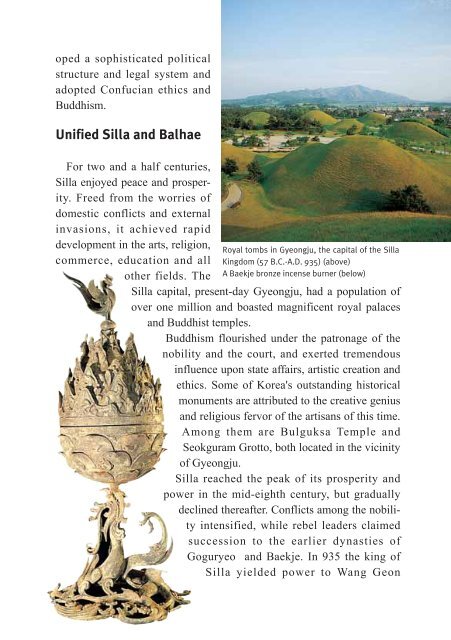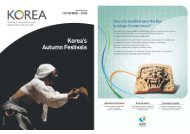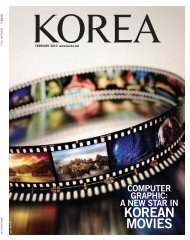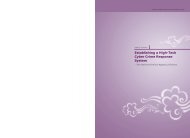HELLO from KOREA
Hello-Eng(3.3) - Korea.net
Hello-Eng(3.3) - Korea.net
- No tags were found...
Create successful ePaper yourself
Turn your PDF publications into a flip-book with our unique Google optimized e-Paper software.
oped a sophisticated political<br />
structure and legal system and<br />
adopted Confucian ethics and<br />
Buddhism.<br />
Unified Silla and Balhae<br />
For two and a half centuries,<br />
Silla enjoyed peace and prosperity.<br />
Freed <strong>from</strong> the worries of<br />
domestic conflicts and external<br />
invasions, it achieved rapid<br />
development in the arts, religion,<br />
commerce, education and all<br />
other fields. The<br />
Royal tombs in Gyeongju, the capital of the Silla<br />
Kingdom (57 B.C.-A.D. 935) (above)<br />
A Baekje bronze incense burner (below)<br />
Silla capital, present-day Gyeongju, had a population of<br />
over one million and boasted magnificent royal palaces<br />
and Buddhist temples.<br />
Buddhism flourished under the patronage of the<br />
nobility and the court, and exerted tremendous<br />
influence upon state affairs, artistic creation and<br />
ethics. Some of Korea's outstanding historical<br />
monuments are attributed to the creative genius<br />
and religious fervor of the artisans of this time.<br />
Among them are Bulguksa Temple and<br />
Seokguram Grotto, both located in the vicinity<br />
of Gyeongju.<br />
Silla reached the peak of its prosperity and<br />
power in the mid-eighth century, but gradually<br />
declined thereafter. Conflicts among the nobility<br />
intensified, while rebel leaders claimed<br />
succession to the earlier dynasties of<br />
Goguryeo and Baekje. In 935 the king of<br />
Silla yielded power to Wang Geon
















